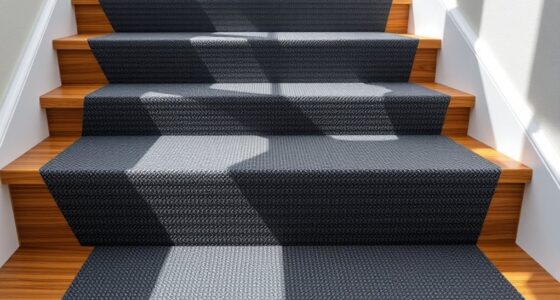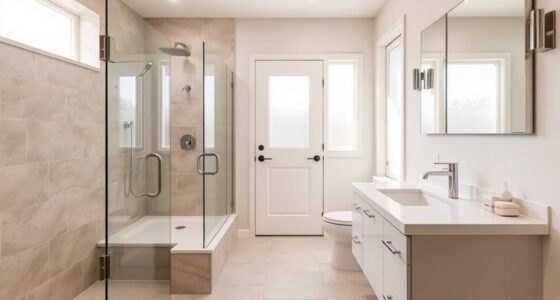To reconfigure your kitchen for seated meal prep, position your appliances like the microwave and toaster nearby your seating area for quick access. Use pull-out shelves, organizers, and clear containers to keep essentials within reach and reduce clutter. Install task lighting over prep zones and consider movable carts or islands for flexibility. These adjustments make your space more accessible, efficient, and inviting. Keep exploring to discover simple ways to create a truly functional and cozy kitchen.
Key Takeaways
- Incorporate adjustable, comfortable seating options near prep areas to facilitate seated meal preparation.
- Reposition appliances like microwaves and toasters for easy access from seated positions.
- Use lower cabinets, pull-out shelves, and accessible storage to minimize reaching while seated.
- Install task lighting focused on prep zones to improve visibility for seated users.
- Create a flexible layout with movable islands or carts to adapt space for seated meal prep needs.

Reconfiguring your kitchen can transform it from a functional space into a more efficient and inviting environment. When you’re focused on creating a setup suitable for seated meal prep, the key lies in thoughtful appliance placement and smart storage solutions. By positioning your appliances strategically, you reduce unnecessary movement and make your kitchen more accessible. For example, placing your microwave and toaster within easy reach near your prep area saves time and effort. Keep frequently used appliances close to your main workspace so you don’t have to walk across the kitchen constantly. This setup streamlines your workflow and encourages a more relaxed, enjoyable cooking experience.
Equally important is optimizing your storage solutions to support seated meal prep. When you have a dedicated space for your ingredients, utensils, and cookware, everything becomes more organized and readily available. Consider installing pull-out shelves or drawer organizers to keep essentials at your fingertips. Clear containers for dry goods help you quickly identify what’s inside, saving you from rummaging through cluttered cabinets. Also, think about creating a designated spot for your cutting boards, knives, and mixing bowls near your seating area. This minimizes the need to move around the kitchen repeatedly and keeps your prep zone tidy. Additionally, efficient storage can help maximize limited space and improve overall functionality.
Optimize storage with pull-out shelves, clear containers, and dedicated zones for utensils and cookware for seamless seated meal prep.
In addition, adjusting your cabinet and counter layout can make a big difference. Lower cabinets or open shelving can serve as quick-access storage for frequently used items, so you’re not constantly reaching up or digging through deep cabinets. Incorporate a dedicated drawer or small cart nearby for utensils and small tools, making them easy to grab when seated. If space allows, consider a movable island or a portable cart that can serve as both prep surface and storage hub, giving you flexibility in how you arrange your space.
Lighting also plays a crucial role in a reconfigured kitchen designed for seated meal prep. Proper task lighting over your prep area ensures you can see what you’re doing without straining. Adjustable lighting options let you create a cozy, inviting atmosphere while maintaining enough brightness for detailed tasks. By combining thoughtful appliance placement, efficient storage solutions, and good lighting, you create a kitchen that adapts seamlessly to your seated meal prep needs. The result is a space that feels less cluttered, more functional, and genuinely welcoming, making every meal preparation session a more pleasurable experience.
Frequently Asked Questions
How Can I Optimize Lighting for Seated Meal Prep?
You should optimize lighting by combining ambient and task lighting. Use bright, even ambient lighting to illuminate the entire space and reduce shadows. Add focused task lighting over prep areas and seating zones to make sure you see clearly while working and eating. Adjustable fixtures or pendant lights work well, allowing you to direct light where needed. This layered approach creates a comfortable atmosphere and improves safety during seated meal prep.
What Safety Measures Should Be Considered in Reconfigured Kitchens?
You should prioritize fire safety by installing smoke alarms, keeping fire extinguishers accessible, and ensuring clear escape routes. Follow strict sanitation protocols to prevent contamination, including proper food storage, handwashing stations, and regular cleaning schedules. Additionally, consider slip-resistant flooring, adequate ventilation, and safe equipment placement to minimize accidents. These safety measures protect both staff and diners, creating a secure environment in your reconfigured kitchen.
How Do I Choose Ergonomic Furniture for Seated Meal Prep?
Imagine yourself comfortably seated at an ergonomic chair with lumbar support, feeling the perfect height of adjustable counters under your arms. To choose the right furniture, look for ergonomic seating that promotes good posture and adjustable features that suit different users. Guarantee counters can be tailored to your height, reducing strain. Prioritize quality, durability, and ease of cleaning to create a safe, efficient space for seated meal prep.
What Appliances Are Essential for Efficient Seated Meal Preparation?
You need essential appliances like a compact stove, microwave, and refrigerator for efficient seated meal prep. Proper appliance placement guarantees easy access, so position frequently used items within arm’s reach. Incorporate smart storage solutions like shelves and drawers to keep appliances organized and maximize space. This setup minimizes movement, streamlines your workflow, and makes meal prep more comfortable, efficient, and enjoyable.
How Can Noise Levels Be Minimized During Meal Prep?
To minimize noise levels during meal prep, you should use soundproofing techniques like adding acoustic panels or mats to absorb sound. Incorporate acoustical treatments such as ceiling tiles or wall panels to reduce echo and noise transmission. Keep appliances well-maintained to prevent loud operation, and opt for quieter models when possible. Additionally, using soft-close cabinet hinges and rubberized mats can help dampen noise, creating a more comfortable environment.
Conclusion
By reconfiguring your kitchen for seated meal prep, you create a more inviting and efficient space. Did you know that 65% of home cooks find that comfortable seating boosts their cooking enjoyment? So, investing in a cozy spot not only enhances your experience but also encourages more home-cooked meals. Make small adjustments today—like adding a bench or a compact table—and transform your kitchen into a functional, welcoming hub for meal prep and socializing.









